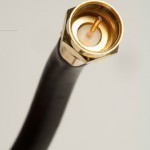A patch panel is a panel that houses multiple cable connections. It is also known as a jackfield or patch bay. The back of the panel has wiring or other connective cabling that runs to disparate equipment. The front of the patch panel allows easy access to connect the different equipment with the use of short patch cables. Before automatic telephone switching became widespread, huge arrays of patch panels were used, in which early telephone operators would connect callers to their intended parties manually by plugging in a cable on Read More
Multi Mode Fiber
Multi-mode fiber is a type of fiber optic cable which is thick enough for light to follow several paths through the code. Multi-mode fiber is best suited for use in short lengths, such as those used in Local Area Networks (LANs) and Storage Area Networks (SANs). Multi-mode fiber comes in two standard widths, 62.5 micron and 50 micron. A micron is one millionth of a meter. 62.5 micron multi-mode fiber can support Gigabit Ethernet over distances as long as 275 meters; 50 micron multi-mode fiber can increase that range to Read More
Dark Fiber
In fiber optics, a dark fiber is any optical fibre that is currently not being used in the ever expanding fiber optics network. Because the fibers have already been laid out, they can be used by anyone should they be leased from the network service provider such as AT&T or Sprint. However, because they are not currently being used, they have gained the name dark fiber or unlit fiber. Why Is There Dark Fiber? The reason for dark fiber is a two fold answer. The first and foremost is the Read More
Optical Networking
Modern technology has provided us with many things over the past few years, one of which is optical networking. By using optical networking, individuals and organizations alike are able to stay connected to the world much more efficiently and with faster data transfer rates than ever before. Fiber optics have revolutionized the world of communication, business, and entertainment in ways that we could not have possibly conceived of a decade ago. In this article, we will discuss optical networking, how it works, and various types of optical networks. What is Read More
Fiber Optic Internet

Everyday, data transfer rates are getting faster and faster as technology gets better and demands get higher. To keep up with these faster data transfer needs, fiber optic Internet access has been introduced to the public. Fiber optic Internet uses pulses of light to create an electromagnetic carrier wave that can be used to send data at very high speeds. In this article, we will explain how fiber optic Internet works, compare fiber optics with coaxial Ethernet cables, compare fiber optics with wireless internet, explain what direct fiber and Read More
Attenuation
Attenuation is a reduction in signal strength over distance. Attenuation is a common problem of telecommunication cables that causes a decrease in data speeds on longer cables. Attenuation is also known as “loss” and can be countered by data repeaters and amplifiers. While attenuation is a problem for long cables, short cables do not usually experience high amounts of attenuation, even if the same amount of data is transferred. How Attenuation Works Attenuation is caused by resistance of electricity in the cable it is transferred through, which causes waste and Read More
Cable Ties
A cable tie, also commonly called a zip tie, is a length of strong Nylon lined with a gear rack. On one end of the tie is a small square case through which you can feed the other end of the tie. The teeth on the tie are arranged in a saw-tooth pattern, and the case contains a ratchet which locks against the teeth, preventing the tie from being pulled back. The simplest way to remove the cable tie is to cut the plastic and discard it afterward. It is Read More
Network Cable is Unplugged

When an error message saying, “Network cable is unplugged” is displayed, it generally means that the computer can detect that there is an ASDL and/or Cable Connection pre-configured on the computer, but an Ethernet cable and/or a cable that is supposed to be plugged into the modem is unplugged. In the case that all of the cables are plugged in correctly but the error message is still displayed, there are three possible problems. Kinked Cable One of the cables may have a kink. The old cable will have to be Read More
How to Splice a Coaxial Cable

A coaxial cable can be spliced with a minimal set of tools, but some of them are specialized. They can be found at a local hardware store. Purchase the following: Two F connectors A barrel connector A pair of diagonal pliers A coaxial cable stripper (preferably) or a knife. A knife is not recommended. A coaxial crimping device for the F connectors Before beginning, the user should determine the type of cable he/she has. Check the marking on the cable for its designation. The most common types are RG6 and Read More
RJ-11
RJ-11 is the standard connector utilized on 2-pair (4-wire) telephone wiring. RJ stands for “Registered Jack”- a physical connector interface most often used for telephone wire terminals. Though the RJ-11 connector has a total of 6 connector positions, typically either only 2 or 4 are actually utilized. RJ-11 connector wiring comes in two standard varieties- untwisted (flat-satin cable) and Unshielded Twisted Pair (UTP). RJ11 is the most familiar of the registered jacks, due to the fact that virtually all single line (POTS) telephone jacks in most homes and offices in Read More


Share on: